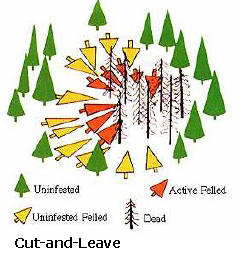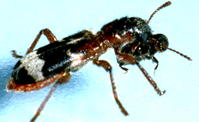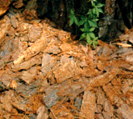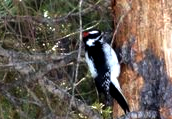Control
Southern Pine Beetle can be controlled with chemical treatment, cutting and removing, and directional cutting and leaving. The methods depends on the severity of infestation, damage, and timber markets.

 Buffer
Buffer
The buffer method of control removes trees that have been killed, recently attacked (yellow and red) and green trees as a buffer. In some cases depending on potential checkered beetle populations not all trees killed will be salvaged unless the potential for wildfire is high.
Cut-and-leave
Cut and Leave (Directional Felling) is very effective in disrupting SPB pheromone production and attack behavior.
Pheromones are produced by SPB to control the behavior of other SPB to mate, mass attack or disperse.

Checkered beetle
A major predator to the SPB is the checkered beetle Thanasimus dubius Fabricius. The checkered beetle eats pine beetles, as shown here, which can help control SPB at all densities.
Temperature
Temperatures around zero degrees (F) for several days have also shown to have an effect on beetle mortality for all life cycle stages. Temperatures around 20 degrees (F) for several consecutive days have been effective in killing the egg and larval stages.

 Woodpeckers
Woodpeckers
Woodpeckers also help to control SPB and indicate there may be a problem in a given stand of trees. Woodpeckers strip away the bark to prey on SPB and create piles of bark at the base of trees. Woodpeckers are predacious on all life stages of the SPB but prefer the pupae and adult because they are easier to find and excavate. While the trees targeted for SPB foraging will die, the number of SPBs remaining to infest other trees is reduced.
Other methods
Other control measures include the pile and burning of small diameter infested trees and chemical spraying. At this time it appears that in the most known infested areas the trees maybe not be suitable for burning due to their large size. Chemical spraying at this time is not recommended due to the large area in need of treatment and labor intensive efforts needed to make it effective.


